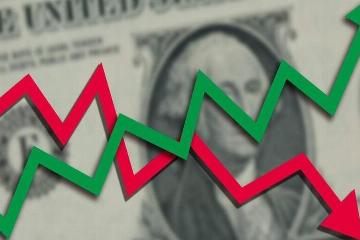End of the US Treasury Low-Rate Era
Advertisements
- February 6, 2025
Looking into the mid-to-long term, there is a prevailing suggestion to focus on investment opportunities emerging from China's embrace of Industrial 4.0 amidst the backdrop of globalizationThis new phase of industrialization, driven by smart manufacturing, represents the fourth industrial revolutionIt harnesses advanced information technology to overhaul traditional manufacturing processes and drive industries toward a more digitized and interconnected existence.
A key question arises: are US Treasury rates gearing up for a new prolonged upward cycle? Since World War II, the US has experienced a lengthy uptrend in bond yields spanning 40 years (1945-1984), which was followed by another extended downtrend lasting until nowPresent conditions—marked by a rise in ‘de-globalization’—are constraining US inflation levels while simultaneously bolstering the credibility of the dollar
Advertisements
Simultaneously, Industrial 4.0 is poised to elevate potential growth rates for the global and Chinese economiesThus, the scenario for US Treasury rates entering another long-term upward cycle appears increasingly feasibleEven with predictions of a recession looming for the US economy in 2022, high Treasury rates are likely to persist as a means of curbing inflationary pressures.
Industrial 4.0 signifies a potential new growth engine for the global economy, with China positioned to emerge as a pivotal playerThis concept, conceived in Germany back in 2013, focuses on smart manufacturing methodologies to catalyze industrial transformationMajor projects under this umbrella include the Internet of Things (IoT), smart cities, and intelligent vehiclesVarious nations have been rolling out explicit policy frameworks; examples include Germany's "Industry 4.0 initiative" and the United States' "Industrial Internet." In May 2015, China initiated a comprehensive strategy to develop a strong manufacturing sector while intertwining low-carbon development goals
Advertisements
With such abundant policy guidance, China is on an upward trajectory toward sustainable and high-quality growth, potentially becoming an essential leader in the global roll-out of Industrial 4.0.
Examining the long-term cyclical dynamics of US Treasury yields reveals a shift in competitive advantages favoring ChinaWhen considering inflation levels, the constraints imposed by de-globalization do limit inflation heights in the US, yet China does not show the groundwork for stagflation, owing to sound monetary and credit policiesThe structural oversupply seen in the A-share market during 2022 further alleviates inflationary pressuresMoreover, as Industrial 4.0 gains traction, expectations for potential global economic growth are increasingChina appears to have seized the initiative in this domain, while the US lags relative to its speed of advancement in Industrial 4.0 technologies
Advertisements
Though de-globalization can temporarily strengthen dollar credibility, it does so based on comparative weaknessesIn contrast, China's commitment to globalization, particularly in the context of Industrial 4.0, could enhance the credibility of the Renminbi, albeit not enough to destabilize the dollar's fundamental reputation.
In order to capitalize on these dynamics, there are three primary investment lines concerning advantageous Chinese assets that investors should monitor.
The first line relates to post-pandemic recoveryAs economies heal from the pandemic's aftermath, structural expectations for improvement arise, particularly in manufacturingChina stands to benefit from external demand thanks to its global supply chain advantages in sectors like photovoltaics and automotive electronics
- Monster Charging Eyes Private Exit, Investors at Risk
- Navigating the $36 Trillion U.S. Debt Crisis
- Record High in Korean Engineering Orders
- Unexpectedly Broad Credit Policy Stabilizes Lending
- Record High for Japanese Corporate Bankruptcies
The second focus pertains to consumer recovery, which will be fueled by spontaneous spending from households coupled with supportive consumer policies aimed at boosting retail, sports goods, and beauty sectors.
Following that, we enter a new phase of economic stimulus which I refer to as 're-leveraging.' The shift from restrictive policies to more permissive frameworks in areas such as real estate and consumer goods will be enlighteningThis includes governmental support in leveraging fiscal incentives and benefits for businesses, particularly in high-potential industries like medical equipment and emerging sectors that focus on scaling production capacity, such as energy storage and battery chemistryMoreover, government-driven investments within infrastructure projects (new infrastructure like wind, solar, and data centers) present further opportunities.
Finally, the third main line concerns sectors benefiting from inflation

In a context where global conflicts escalate and contribute to the ‘de-globalization’ narrative, inflationary pressures compound, partly due to stagflation risksNevertheless, investing in the new energy supply chain encompassing production and usage is increasingly criticalThis overview encapsulates the dual perspective that while demand for traditional energy and materials will rise, it could also effectively create an "outflow effect" on capital investments directed towards conventional energy materials—such as coal, lithium, and potash—leading to a reevaluation of their valuations as stable demand persistsAdditionally, focus should remain on sectors poised to benefit from the PPI-to-CPI transmission affecting consumer goods such as home appliances and beverages.
In midst of the uptick in US Treasury rates, sectors congruent with Industrial 3.0 are likely to continue yielding exceptional returns
Even should current Treasury rates not trend upwards, they are expected to maintain high positions, reinforcing the underlying creditworthiness of the dollarLooking ahead, investments associated with China’s Industrial 4.0 narrative warrant keen attention, primarily focusing on dynamic Chinese tech firms analogous to the FAANG group in the US.
The China FAANG denotes a critical axis within the Industrial 4.0 framework, aligning with the broader theme of ‘high-quality development’ powered by profit margins within consumption, intelligent manufacturing, and low-carbon initiativesFirstly, China’s consumer landscape exhibits promising recovery in profit margins, spurred by a demographic advantage and geographic positioning that continues to promote the overarching trend of consumption upgradingSectors like high-end liquor, local brands, and both aesthetic medicine and beauty products are likely to benefit from this shift
Leave A Comment